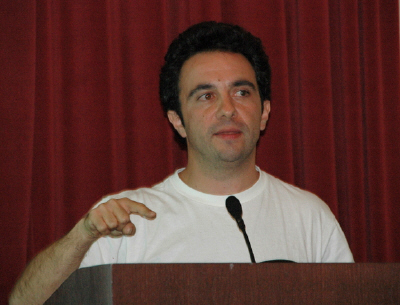Liveblogging AttentionTrust and GestureBank Announcements

Continued coverage of the AttentionTrust luncheon follows:
Comments from Seth Goldstein: Seth discusses attention attributes that have quantified value, email addresses, etc. On the Internet, our gestures (what we do, what we don't do) form this mass of data. And increasingly, that attention data comes to represent who you are, your identity. Daphne, the Goddess of Integrity, was fleeing from Apollo, was telling the truth and was turned into a tree. AttentionTrust is a high search result for 'attention' without practicing any form of SEO.

In December '05, del.icio.us sold its users' tags to Yahoo! PC Forum this year was themed 'Users in Control.' Ray Ozzie has said of Windows Live, "the core is Optimization." The presumption "We will monitor..." bothers Seth. Defendant number one of AttentionGate: AOL's Abdur Chowdhury. The symptom of attention makes the front page of the New York Times. "Those are my searches," said Thelma. Seth thinks Abdur wanted to produce a new social attention algorithm (anonymity be darned) to distinguish himself from his fellow geeks. This is totally Seth's interpretation, his read on this. Something inspired the stupidity, this is Seth's theory as to what. (Dave Sifry comments from the audience that this sort of speculation may reflect more negatively on Seth than on Abdur, and Seth takes the point.)
Future attention remains contingent. Companies want to listen to users, and users want to be heard. Google, MySpace, Facebook, etc. all assume people have free choice in what services they use. The pages are being built dynamically on the fly, based on the explicit and implicit interests of the users. The users' attention is leveraged to leverage the attention of other users. In 2,000, Josh Harris practiced self-surveillance to an extreme: turned a Web cam on himself, his girlfriend, their lives. Strange things happen when physical gestures turn into electronic signals. The broader you is missing from the transaction. ... [Seth is reading from a post I will attempt to link to, rather than attempting to capture/paraphrase; I'm told it will be up in a couple of hours. Update: here it is.] As of today, Seth has resigned his operating role at Root to focus entirely on putting users in control, will now drive a company called AttentionSoft. The purpose is to address and answer the question, "Why would anyone want to expose their clickstream?" Between having a recorder "on," and "off," is a whole ecosystem of what you're sharing, who with, what is prefiltered, what is postfiltered...
Comments from Steve Gillmor: Steve asks Dave Sifry to join him, and Dave describes how, when they first met, Steve laid out an extremely passionate vision for capturing the data we create in the act of living. (Note that Michael Goldhaber first began working on these ideas with Esther Dyson in 1992.) Today, Steve is announcing GestureBank. Robert Anderson and Steve have been working on this for about a year. Steve describes how Dave Sifry gifted Attention.xml to the community. Robert Anderson is the CTO of Digipede. Steve is involved in a land grab on behalf of users, and this is why he's taking over AttentionTrust. Vendors are our friends, not our enemies. We're all mercenaries in this space, we're all out for our families and our friends. What we need to do is develop mechanisms that preserve the users' autonomy, preserve the user being in charge. GestureBank will become an integral part of the AttentionTrust to protect it from everyone, "including ourselves."
Principle one, RSS is dead. The river of news is overflowing its banks; feedreaders are commoditized; TechMeme is the new Home page; links, page rank and search are gamed; Signal is Noise; Attention deficit is exploding.
Principle two, Attention is broken. there's a lack of user control; it's built on inference; it's managed behind silo firewalls; there is silo balkanization; there are implicit privacy concerns; there is a commodity content incentive model [DMH note: consistent with what Steve is ranting about here, I'm not putting a "more" link on this lengthy post; you get to decide whether this is important enough to read, and not generate clicks and/or view further ads].
In the trenches with Steve. We're back to manually searching our trusted sources for what's important [DMH note: some of us have never adopted the feedreader option for precisely this reason]. You're left with triage, starting with your vanity feed. "Woke up, fell out of bed...:" Who is/isn't talking about you? Who agrees with you? Who doesn't?
Attention 2.0:
- Email/IM to alerts: follows browse to feed notification transition; pushes collaborative communications to RSS; GChat blurs email and IM streams to indistinguishability; GReader blurs the river of news and RSS email models in just the same way.
- No linking -> Citation: reduces wasted clicks; encourages meme (topics driven) and name searches; supports gesture dynamics (more on this in a moment); it defangs splogs and siloed attention streams; and, it promotes affiniity formation.
- Troll Isolation: citation (in lieu of links) reduces troll reward (can even turn trolls into partners), and encourages context; deprecates comments and brand scraping; identifies low-value affinity groups, which can have enormous value by helping you identify things you will be interested in more than others, high value in terms of their filtering.
- Inference commoditization: accelerates the move to efficiency; encourages standardization and spec normalization; helps identify silo signatures; surfaces black hole dynamics. AttentionTrust has been approached by many competing attention related specifications for endorsements. Specifications and standards should come from a market force driven consensus, the product of a triage or rollup of the entire ecosystem. Smart/strong standards will out. This transfers tremendous power to the users. If you are trapped in "the MS Office hairball," you are forced into behavior patterns that slow you down and create the need to buy upgrades to improve the experience. Black hole dynamics = if you're in a river of news, full text feed, you're reading the content inside whatever reader or experience you're using. The implications of successful use of this type of technology are far different from the average browser or page view model. There are high value customers you're missing if you're not penetrating the black hole. [DMH aside: Dave Sifry asked me if I understood what Steve meant by this. I think I do. I believe it means that a growing group of users is consuming information in media, like GMail and GReader, that render their behaviors invisible (a "black hole). And the corollary is that these users, even if they may be a small percentage of the total universe of users, are highly influential and/or predictive of the behaviors of the balance. GestureBank 2.0 will weight these kinds of behaviors commensurate with the value of what goes on in what would otherwise be the "black hole." The black hole represents a higher value audience, that may warrant offering higher incentives to pierce the black hole.]
- Affinity (trust) harvesting: If...you could prioritize by core affinity, prune duplicates, throw out low value crap, delegate editorial, harvest subscriber, and automate the midtail...you could have something called GestureBank.
GestureBank: There are no privacy issues here. There is opt-in, opt out in a pre- and post-filtered way. The pool of data is open and anonymized. Individual streams are owned and controlled by the user. Period. Affinity groups are owned and controlled by the members of the affinity groups. Data access is only by a contribution key. If you don't contribute, you don't have access. On a stream by stream or affinity stream basis, you only see that under contract directly with the user.
GestureBank 2.0 embeds the open data pool in the (Attention) Trust for users. It manages anonymous affinity group membership through an anonymous revocable key. It enables affinity group-only content. And it guarantees the independence and user control of the open Pool.
Timetable: Steve has already returned as the President and board director for AttentionTrust. Robert Anderson will continue as the GestureBank architect at AttentionTrust 2.0. GestureBank will be integrated within two weeks. The API will enter development beta the following week. Affinity Services will launch by the end of October.
What we need is to get a good pay for a good day's work. A good day's work in the attention economy which Michael Goldhaber began modelling for us is not just what we do, but what we don't do. Not just what we say, but what we don't say. This model will incent the creation of more of the kind of content that we're looking for. It's not just about solving information triage issues under the current regime of incumbents. It's about creating new incumbents. There's a lot of economic power here that can be exploited.